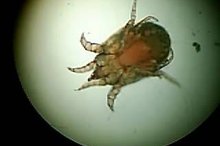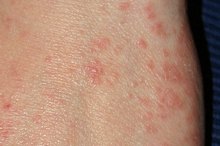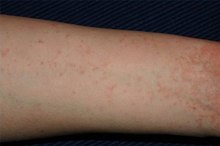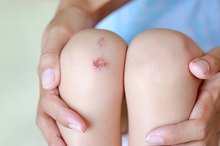What does fact checked mean?
At Healthfully, we strive to deliver objective content that is accurate and up-to-date. Our team periodically reviews articles in order to ensure content quality. The sources cited below consist of evidence from peer-reviewed journals, prominent medical organizations, academic associations, and government data.
The information contained on this site is for informational purposes only, and should not be used as a substitute for the advice of a professional health care provider. Please check with the appropriate physician regarding health questions and concerns. Although we strive to deliver accurate and up-to-date information, no guarantee to that effect is made.
Mange Treatment for Humans
Mange is a generic term describing the condition caused by mites on or near the skin surface in dogs, cats, cattle, hogs, sheep and humans. Each different species has its own particular sarcoptic mite that attempts to set up life in its skin.
Dogs don't catch human mange. Cats don't catch dog mange.
And humans don't catch mange from their pets or other animals. In humans, sarcoptic mange is also known as scabies and has been referred to as the "Seven Year Itch. "
Pet Mange
While humans don't get mange from the mites that create the condition on dogs and cats, occasionally, a mite from an infected family pet will find its way onto a person. While the dog and cat varieties of mites don't set up burrows and lay eggs under human skin, the way they do on their feline and canine hosts, their presence on humans can cause red welts similar to those created by a mosquito bite.
It is not necessary to provide treatment to kill the mites because they cannot survive on a human host. However, cortisone is sometimes prescribed to reduce inflammation and help control itching.
- While humans don't get mange from the mites that create the condition on dogs and cats, occasionally, a mite from an infected family pet will find its way onto a person.
- While the dog and cat varieties of mites don't set up burrows and lay eggs under human skin, the way they do on their feline and canine hosts, their presence on humans can cause red welts similar to those created by a mosquito bite.
Human Mange
How Long Can Scabies Eggs Live?
Learn More
In mammals, the microscopic mite burrows into the upper layer of skin where it lives and lays its eggs creating a condition referred to as mange. In humans, the condition is most commonly known as scabies. It is common for outbreaks of scabies to occur in places where there are many people in close contact, such as nursing homes, prisons and child care facilities.
Close body contact is required for scabies to infect one human from another human, the only way in which it can be transmitted. Because of this, it is often sexually acquired.
- In mammals, the microscopic mite burrows into the upper layer of skin where it lives and lays its eggs creating a condition referred to as mange.
Symptoms
Scabies create an intense itching and a pimple-like rash. In a person who has never had scabies before, symptoms may not be present for up to two months after the time of infection. However, during all of that time, the infected person can be infecting others without knowing she has the mites on her skin.
If a person who has had scabies before is re-infected, symptoms may appear one to four days after the new infection.
Itching tends to be most severe at night and the pimple-like rash occurs between the fingers, on the wrists and elbows, and on the armpits, penis, nipples, waist, buttocks and shoulder blades. In young children and infants, the rash is often present on the head, face, neck, palms and soles of the feet.
- Scabies create an intense itching and a pimple-like rash.
- In a person who has never had scabies before, symptoms may not be present for up to two months after the time of infection.
Crusted Scabies
What Are Skin Symptoms of Mites?
Learn More
A more severe infection of human mange is known as "crusted scabies." Those who are elderly, disabled or debilitated in some other way are at risk of having a scabies infection turn into this more contagious variety. With crusted scabies, thick crusts appear and these crusts contain large numbers of mites and mite eggs.
A person infected with crusted scabies is extremely contagious. **With this level of scabies, bodily contact is no longer necessary for the mites to pass from one human to another.
The mites can be transmitted through the infected person's clothing, bedding and furniture. A person with crusted scabies should seek medical attention immediately. **
- A more severe infection of human mange is known as "crusted scabies."
- A person with crusted scabies should seek medical attention immediately.
Diagnosis
**Scabies is usually diagnosed in people by the appearance of the rash.
It should, if possible, be confirmed by a positive identification of the mite or the mite eggs. This can be done by removing the mite from the end of its burrow using the tip of a needle or by taking a skin scraping. These can then be examined under a microscope 3. ** Even if no mites are found, you can still be infected. As few as 10 to 15 scabies mites can create symptoms of sarcoptic mange.
- Scabies is usually diagnosed in people by the appearance of the rash.
- This can be done by removing the mite from the end of its burrow using the tip of a needle or by taking a skin scraping.
Treatment
When diagnosed with scabies, not only should the infected person be treated, but so should everyone who lives in that person's home, his sexual partners and other close contacts. Everyone should be treated at one time to prevent re-infection. Scabicides, which kill the mites and mite eggs, can only be purchased with a doctor's prescription. There are no effective over-the-counter products for scabies. The body should be covered in scabicide lotion from the neck down to the soles of the feet and toes.
In children and infants, the scabicide should also be applied to the head and neck.
The treatment should be applied to clean skin and left on for the product's recommended amount of time. Clean clothing should be worn following treatment. Itching can continue for two to four weeks after treatment.
- When diagnosed with scabies, not only should the infected person be treated, but so should everyone who lives in that person's home, his sexual partners and other close contacts.
- In children and infants, the scabicide should also be applied to the head and neck.
Environment
Treatment doesn't end with getting the mites off of your body.
Your environment must be treated in order to prevent re-infection. Bedding, clothing and towels used by the infected person, members of the infected person's household, and the infected person's sexual partners and other close contacts should be washed in hot water and dried in a hot dryer, dry cleaned or sealed and put in a plastic bag for at least 72 hours.
Related Articles
References
- Vet Info
- Centers for Disease Control
- Dan Wasmund DVM, The Pet Stuff Online Newsletter
- Scabies. World Health Organization.. May 20, 2019.
- CDC - Scabies - Disease. Centers for Disease Control and Prevention. Nov 2, 2010.
- Harvard Health Publishing. Scabies. Harvard Health. Dec 2018.
- Mrázová Z, Jadrníčková I, Brabcová K, Spurný F. Fragmentation of Ne ions with energy 400 MeV/u behind targets from different materials measured with PNTD. Radiation Measurements. 2010;45(10):1438-1440. doi:10.1016/j.radmeas.2010.06.048.
- Patel VM, Lambert WC, Schwartz RA. Safety of Topical Medications for Scabies and Lice in Pregnancy. Indian J Dermatol. 2016;61(6):583-587. doi:10.4103/0019-5154.193659
- CDC - Scabies - Resources for Health Professionals - Medications. Centers for Disease Control and Prevention. Oct 2, 2019.
- CDC - Scabies - General Information - Frequently Asked Questions (FAQs). Centers for Disease Control and Prevention. Oct 24, 2018.
- Arlian LG, Morgan MS. A review of Sarcoptes scabiei: past, present and future. Parasit Vectors. 2017 Jun 20;10(1):297. doi: 10.1186/s13071-017-2234-1.
- CDC. Scabies. Resources for Health Professionals, Medications.
- Micali G, Lacarrubba F, Verzì AE, Chosidow O, Schwartz RA. Scabies: Advances in Noninvasive Diagnosis. PLoS Negl Trop Dis. 2016 Jun 16;10(6):e0004691. doi: 10.1371/journal.pntd.0004691. eCollection 2016 Jun.
Writer Bio
Bethney Foster is social justice coordinator for Mercy Junction ministry, where she edits the monthly publication "Holy Heretic." She is also an adoption coordinator with a pet rescue agency. Foster spent nearly two decades as a newspaper reporter/editor. She graduated from Campbellsville University, receiving a Bachelor of Arts in English, journalism and political science.








